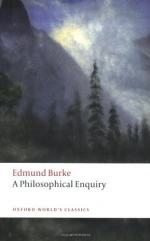
|
| Name: _________________________ | Period: ___________________ |
This quiz consists of 5 multiple choice and 5 short answer questions through Part IV, Sections VIII - XXV.
Multiple Choice Questions
1. What is the main manifestation of infinity Burke mentions?
(a) A quiet walk in a grove of trees.
(b) A seemingly endless journey.
(c) A frequently repeated idea or motion.
(d) A recurring dream or nightmare.
2. According to Burke, what is the mechanical reason darkness is terrible?
(a) The eye's compensation for darkness causes pain.
(b) The brain's ability to think is much reduced.
(c) The skin becomes less sensitive and reduces feeling.
(d) The body's processes slow down.
3. Why is grief a part of pleasure, according to Burke?
(a) Because grief reminds the individual that life continues.
(b) Because people actively and willfully grieve.
(c) Because all endings are beginnings.
(d) Because grief always gives way to laughter.
4. According to Burke, why is procreation pleasurable?
(a) Because without some form of pleasure, society would devolve into warfare.
(b) To connect humans and animals in the realm of the senses.
(c) To incite people to engage in it, since it is necessary to survival.
(d) Because the rest of life is terrible, and there must be at least one pleasurable thing in life.
5. Which of the following does Burke assert about beauty?
(a) That beauty is in the eye of the beholder.
(b) That it combines with proportion to create the sublime.
(c) That it has nothing to do with proportion.
(d) That proportion is critical to it.
Short Answer Questions
1. What example does Burke use to demonstrate that differing tastes stem from the same basic root?
2. What size of objects does Burke consider "beautiful?"
3. According to Burke, what parts of the mind do beautiful things engage, and how?
4. How do smells and tastes become sublime most effectively?
5. How does Burke define sympathy?
|
This section contains 401 words (approx. 2 pages at 300 words per page) |

|




